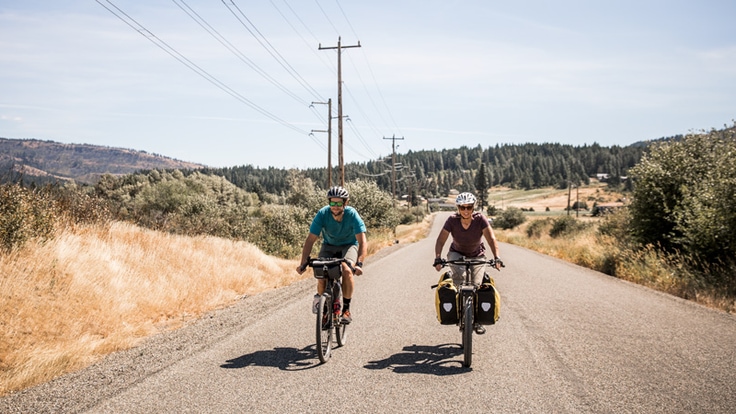Experienced bike tourers appreciate how wonderfully simple bike travel can be: Rolling on two wheels, only as fast as gravity and your two legs can carry you, you travel more slowly than on a plane, train or automobile, giving you time to savor sights and engage with the people and places you pass by. If you're interested in getting started bike touring, it's helpful to learn what's required to have a pleasant experience before you head out the door. This article will help you understand where to go, what bike to ride, what gear and clothing to bring, and how to pack.
What Is Bike Touring?
Think of bike touring as a blend bike riding and backpacking. It typically involves traveling for days, weeks or months at a time on mostly paved roads with the occasional foray onto dirt or gravel (as opposed to bikepacking, which is primarily done on singletrack trails and dirt forest roads.)
There are many different ways to bike tour. You can head out on a self-supported ride where you carry all your gear and clothing with you on your bike and are prepared to camp outdoors and cook meals. Or, you can join an organized tour run by a commercial outfitter that will handle all the planning and even shuttle your overnight supplies in a car to your destination for the day, which is often a hotel. If you don't want to go on an organized tour but aren't up for sleeping outside and preparing meals, then do a credit card tour, where you plan your own adventure but pay for food and overnight lodging as you go.
Where to Go Bike Touring
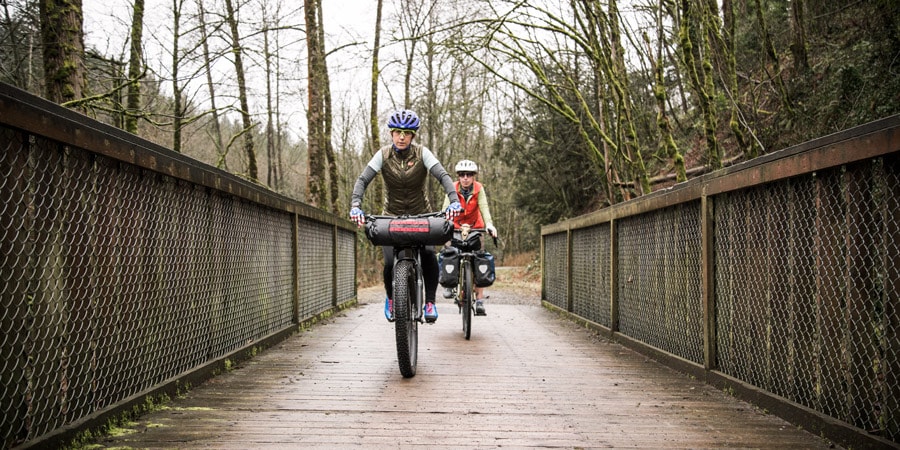
Going on a bike tour can be as simple as a taking a weekend trip close to where you live or as grand as setting off on a months-long international adventure that covers thousands of miles.
When deciding where to go, consider how much time you have, how many miles you want to ride and what you'd like to see along the way. By looking closely at maps and doing online research, you'll be able to piece together a route that takes you where you want to go. As you do so, keep these points in mind:
- Look for established routes: Lots of people have pedaled before you and ridden routes across the United States and abroad, so don't feel you have to blaze your own trail, especially on your first bike tour. Before you set out, spend time online looking for blog posts and websites that describe routes in the area you want to explore. The Adventure Cycling Association has mapped thousands of miles of bike routes all over North America and is an excellent resource.
- Avoid busy roads: Streets with lots of car and truck traffic can be unpleasant and unsafe to ride. Quieter country roads and dedicated bike paths are typically preferred for bike tours, and they're often more scenic, too. To stick to these roads and paths, you may have to pedal a less-direct route to your destination and/or circumvent cities rather than going right into the heart of them. The Rails-to-Trails Conservancy has an online trail finder that's helpful for locating car-free rail-trails and multipurpose paths.
- Consider your proximity to civilization: The closer your route is to a town, the easier it is to stock up on food and find a bike shop if you're having mechanical issues. For your first bike tour, it's a good idea to plan a route close to a developed area.
- Decide where you want to sleep at night: This doesn't mean you need to know exactly where you're going to stay each night before you hit the road, but you do need to decide whether you want to camp or stay in hotels, motels, and bed and breakfasts. Figuring this out affects what gear you need to bring and where your route might take you. Camping is less expensive and can allow you to stay closer to nature, whereas hotels and the like are more comfortable and allow you to carry a lot less gear.
- Expect to ride shorter distances: With a loaded bike, you won't be able to ride as fast and as far as you otherwise would. A reasonably fit adult who has done a bit of bike-specific training and is carrying about 20-40 pounds of equipment on their bike can expect to ride about 50 miles per day. If the route is very hilly, you're carrying more weight than that or you haven't trained at all, expect to ride less.
Learn more about where to go and how to plan your trip in our article, How to Plan a Bike Tour.
What Bike to Ride for Bike Touring
There's no one right type of bike for touring, so if you have a road or mountain bike at home that's in decent working order, you can likely set out on a tour without investing in a new ride. Changes can be made to most bikes to make them better suited for touring, such as changing the gearing to give you really easy gears for going uphill, putting on wider tires to increase comfort, and adding front and rear racks so you can carry panniers.
If you have big plans to tour frequently and ride lots of miles, then you may benefit from a bike that's specifically designed for touring.
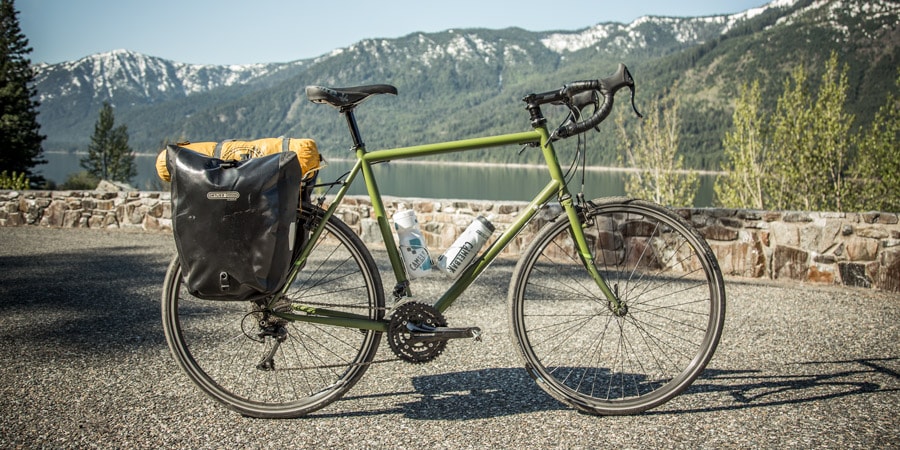
A typical touring bike looks similar to a standard road bike; a touring bike has the same basic shape and usually has dropbars. But there are subtle differences, such as the touring bike's more upright riding position and a geometry that helps maintain stability while carrying lots of weight. Many touring bikes come ready to carry front and rear racks for hauling gear in panniers.
Gravel bikes are built to handle rougher terrain. For instance, many have bigger, knobbier tires for gravel roads and dirt trails. Some use 650b wheels and tires similar to those found on some mountain bikes for better grip and bump absorption on rough roads and trails. Many gravel bikes include mounts for attaching racks to haul gear in panniers.
If you're interested in riding exclusively on dirt roads and trails, you'll also want to read our article, How to Choose a Bike for Bikepacking.
How to Dress for Bike Touring
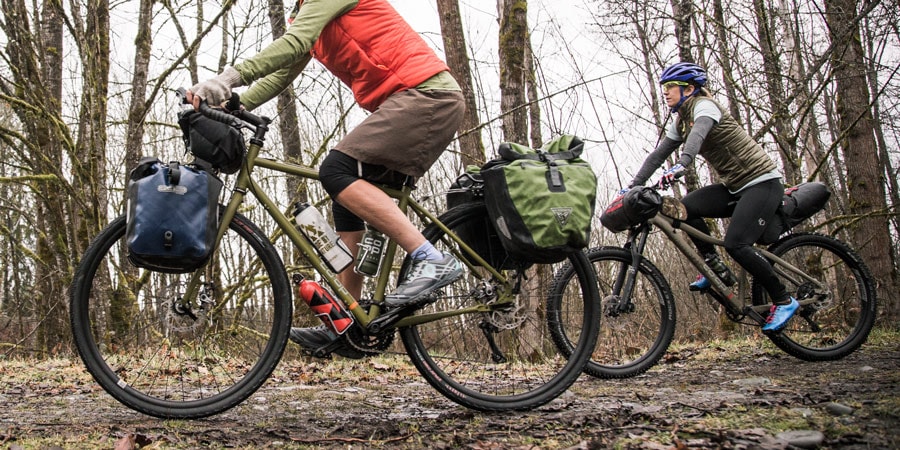
During a bike tour, you're going to be on your bike for many hours each day, and how you dress can play a big part in your overall comfort.
Choose synthetics, like polyester and nylon, or wool. Just like on other outdoor endeavors, you want to avoid cotton when bike touring because it takes a long time to dry when it gets wet and is a poor insulator, which can leave you cold and uncomfortable.
You don't need a lot of bike-specific clothing: Chances are you already own some things that will work just fine. If you're a hiker, items like wicking T-shirts, zip-off pants, a waterproof shell jacket and lightweight wool socks can work really well. However, you will want a few pairs of padded bike shorts to keep your rear end comfortable on the bike. Many bike tourers choose baggy mountain bike shorts rather than tight, stretchy road shorts because they can serve as regular shorts when you're not on your bike.
Choose versatile clothing: Many bike tourers choose performance items with casual style that can be worn on the bike and while strolling through town. Wearing versatile pieces like this saves weight because you won't need separate bike clothes and in-town clothes.
Limit the amount of clothing you bring: Try to carry no more than three or four days' worth of clothing. This applies even if your trip will last weeks or months. Carrying more than that will fill your bags and weigh your bike down. You can wash clothing along the way in laundromats or even a sink with travel soap.
What Gear to Bring Bike Touring
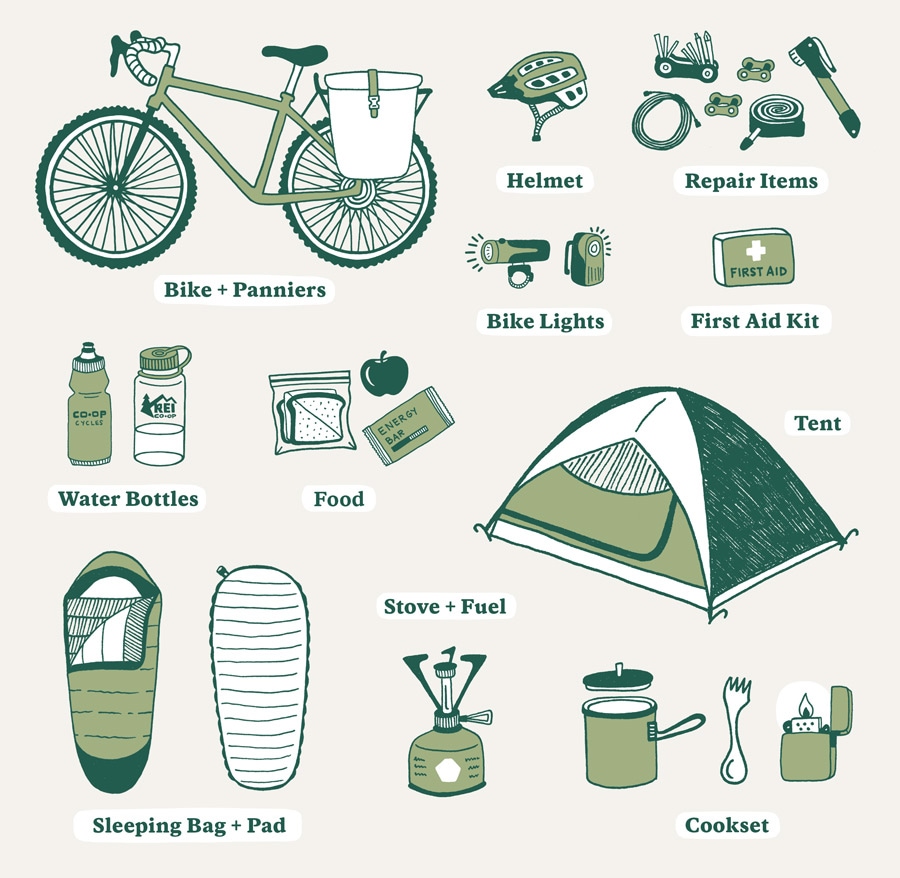
The gear required for a bike tour depends on the type of trip you're taking. If you're doing a so-called credit-card tour (where you'll buy meals along the way and pay to stay in hotels, motels, and bed and breakfasts), then you won't need nearly as much stuff as you will if you're doing a self-supported tour that involves camping.
No matter the type of tour, you'll need the basics: a bike, helmet, bike lights, repair items, water bottles, food, first-aid supplies, and a pannier or two to carry these items.
If you'll be camping some or all the nights, you'll need: standard backpacking equipment, like a tent, sleeping bag, sleeping pad, stove, fuel and a cookset.
For a comprehensive list of what to bring, see our Bike Touring Checklist.
How to Pack for Bike Touring
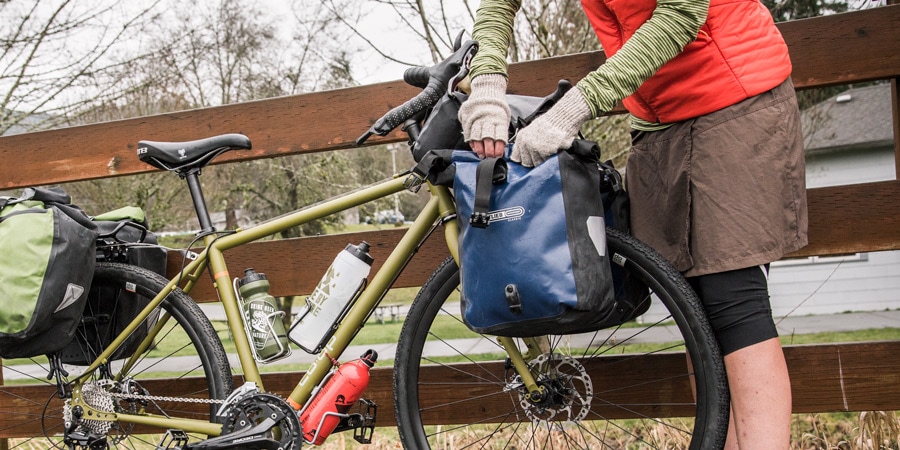
Most bike tourers carry gear, clothing and food in two or four panniers that attach to front and rear racks on the bike. Bike trailers are also an option and are great for hauling lots of gear and/or riding rougher terrain. Exactly what you pack and how you pack it depends a lot on the type of bike tour you're doing.
If you're doing a self-supported tour: You'll likely need four panniers and/or a trailer to fit all your camping equipment and food.
If you plan to buy prepared meals and pay for lodging: Two panniers will typically be enough.
When packing your bags, it's best to put heavy items in first to keep the center of gravity of your bicycle low. You'll also want easy access to items you'll need frequently, like snacks, sunscreen and clothes for the day, so don't bury them too deep.
Learn more in our article, How to Pack for Bike Touring.
